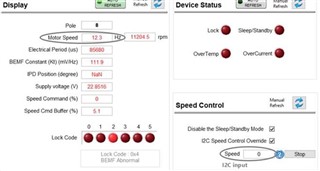Hi team,
Here I find a bug of DRV10983. I use I2C input to control the speed of motor. And the relationship between I2C input and speed is shown as below.

|
I2C input |
Speed |
|
100 |
43.4Hz |
|
200 |
88.6Hz |
|
300 |
133.7Hz |
|
400 |
177.1Hz |
|
500 |
225.9Hz |
However, when I enable the AVS to VCC function and input 100 in the box, the motor speed rushes to 234Hz, which is out of control. There is no such bug when AVS to 24V is enabled. Could you please repeat above test in lab and explain the reason. Thanks a lot!

